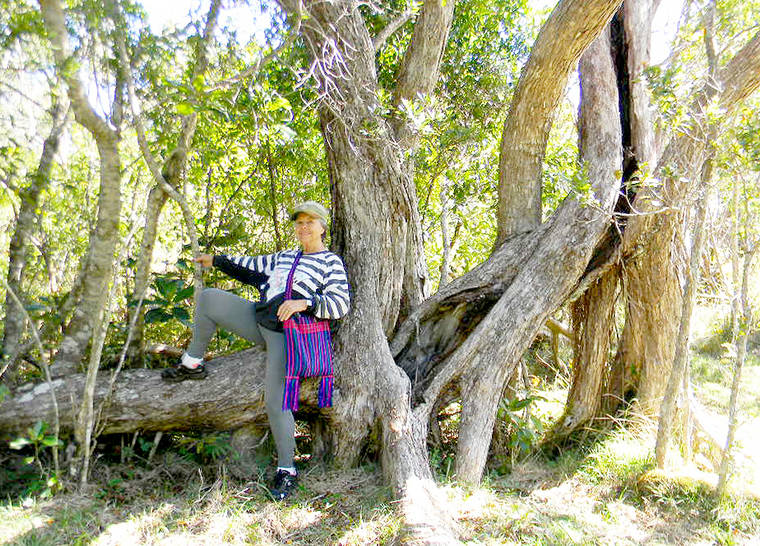This column, my focus shifts to breathe in the healing green of trees rather than concentrate on the contention of a minority of Hawaiian people who break laws and strew opala, rubbish, on the bosom of the beloved Mauna Kea.
Many have jumped on that righteous bandwagon, from movie to pop stars to activist politicians, whereas the demonstrators have shown they have a woeful axe (quite unrelated to the telescope and its purpose) to grind — a not-so-hidden agenda.
How will the majority of educated and/or critical thinkers who have a blood quantum that makes them Hawaiian choose to demonstrate that they, instead, embrace the superior technological advances the Thirty Meter Telescope will offer once built and operable?
Don’t we all wonder what amazing turnaround of thought will be wrought as a result of Gov. Ige’s impending bad-weather buck-pass challenge to Mayor Kim? And what magical shift from the most recent eruption of held-in anger will happen in two years?
Back to trees.
Now, in two years, I can attest, a young Norfolk pine planted in the right medium can grow to approach seven feet tall and get into the I’m-ready-to-be-your-next-Christmas-tree mode. In two years, a poinciana can emerge and become a show-stopping, blossoming sapling.
In two years, a healthy citrus tree can begin supplying bushels of gorgeous, Vitamin C-packed fruits, and a seed-grown papaya (now we’re cheating a bit, because these are actually a form of grass, like banana trees) can bear an outstanding number of delicious fruits. In 2×2 years, a macadamia nut tree can begin producing.
I have written before about my habit of planting trees. I confess this has been a passion wherever my life drew me to settle and call home. I carry a love of trees as far back as memory takes me — and no wonder, since I spent formative years in a town embedded in a forest reserve. In my early youth it was pointed out to me that trees are a living symbol for us, as humans. Even as a kid, I really “got” the parallel my mum drew between trees and myself.
As she explained, when they are planted in the right medium and under the right conditions, their roots spread within the earth, drawing up moisture and nourishment to help the tree grow toward light. In poor soil or challenged with too little or too much moisture, growth can be stunted; the tree may die from drought, or rot from an excess of water.
A challenged or struggling tree is also host to beetles and insects, and other biologic attack (e.g. the ohia lehua of Hawaii island, just now reported as being found in remote areas of Oahu).
Not only can trees shade, shelter us and clean our air, acting as a green lung, they also provide beauty, nourishment and medicine. Trees can bring down home-and-garden (and city) summer temperatures. They “catch” and channel rain. They act as buffers during high winds. Children and youth may climb them, dive from and swing under them. Trees provide homes to birds, insects and woodland creatures. They offer their natural products of syrup, chicle, rubber and more.
The list goes on: trees provide us with building materials when they are felled, planed and planked. Many woods are cut and polished by artisans to create objects of great and/or useful beauty.
Some shining and naturally-crannied seeds of trees are crafted into jewelry, lei or monks’ prayer beads, or mala, as with the Indian Rudraksha “blue marble” seeds. Ulu (breadfruit) and coconut palm trunks in Hawaii are fashioned into pahu drums to beat the stirring rhythm of sacred hula — which inherently means the worship of light, or enlightenment.
It seems my thoughts about beloved trees have circled around and back to the beginning, as with the life cycle of a tree.
Where there are deciduous trees, there will be falling leaves. In time, the trees, too, fall. Decaying leaves and logs send nourishment back into the earth from which they sprang. There is a parallel with human life there that I didn’t understand until I matured.
How could it be that some people are not “in love” with trees and consider their falling leaves, twigs or seedpods to be such a nuisance factor that it looms larger than any other benefit, I wonder as I check on the hard, little green Meyer lemon, tangerine and Kaffir lime keiki (children) developing in my side garden.
Yes, how could that be, as I see the birds flitting in and out of branches; butterflies, and moths, too. Not to speak of a gimpy rooster who appears to think I’ve “hanai-ed” (adopted) him and his harem of roosting wives.
But in all honesty, the Tahitian plumeria tree that is the sundown roosting choice of my wild brood, must very soon be coppiced once again to encourage lateral growth. Likewise, the ulu tree. With hurricane season beginning, I must consider the safety of my neighbors’ roof (and ours, too), and the damage that might occur to their nice, white composite fence.
When I told my young arborist the story behind the planting of my ulu tree, he remarked, “There’s a story for many of the trees I’m called in to cut or trim.” This set me to thinking I would invite you, Dear Readers, to send me your tree stories to include in a follow-up to this, my confession.
•••
Dawn Fraser Kawahara, resident author and poet, has focused her supportive interests within the Kauai community since the early 1980s. She and her husband, a retired biology teacher, live in Wailua Homesteads and share a passion for books and travel. Kawahara’s books are available through Amazon and other outlets. For more information, email tropicbirdpress@gmail.com.



I am trying to find a service that plants trees, on Kauai, in memorial of a loved one who lived on Kauai for over 35 years. Can you help me?
Thank you.
L